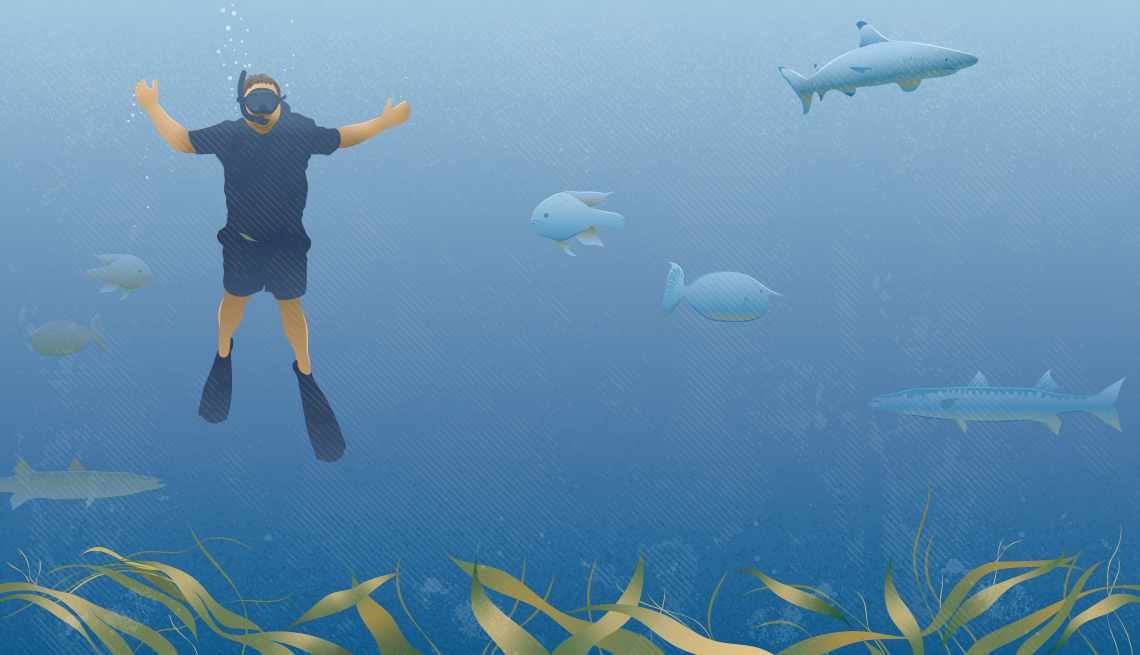
Life's a journey: overcoming fear in fiji | members only access
- Select a language for the TTS:
- UK English Female
- UK English Male
- US English Female
- US English Male
- Australian Female
- Australian Male
- Language selected: (auto detect) - EN
Play all audios:

For most, this would be a dream. For me, it’s a potential nightmare. Heading out on a snorkeling trip, I’ve never seen shades of water this blue. The lush, verdant island shore recedes
behind the dive boat’s long wake, and swooping, swaying palms recede into the endless South Pacific horizon. All around me, people start nonchalantly slipping on snorkels and fins. With each
passing moment, my heart beats faster in my chest and a sense of dread builds in my stomach. I’m in Fiji, an absolute Polynesian paradise, and my two-week trip includes daily water
activities. But right now, there are few things that I fear more than underwater immersion. At age 41, this is new for me. I loved aquatic activities as a kid, and my love of swimming
continued into adulthood. Visiting far-flung destinations as a travel writer, I’ve had the opportunity to snorkel some of the world’s most famous reefs, and I earned my scuba license on a
tropical island in the Philippines. “Come hell or high water, with every day featuring a new water-related experience, I was determined that these two weeks in Fiji were going to restore
that lost part of my life.” Whitewater rafting became a favorite pursuit, and I embraced the thrill of paddling right into the eye of the storm, adrenaline rising as the raft crashed through
frothy waves, the possibility of being thrown into its wild waters always just an inch away. Then I got sucked into a whirlpool. On perhaps my dozenth time paddling whitewater, on a not
particularly technical set of rapids, I was tossed from the raft. I’d been in this position before, on many occasions. Normally, I’d surface a moment later, let the life jacket do its work
and ride the crest of the current to calmer waters, where I would climb back into the raft. But that didn’t happen this time. Instead of promptly popping back into the fresh air, the
churning pool held me down in the dark water for what felt like an eternity. I could see the surface, but like a shirt in a washing machine, the force of the water kept turning me. Up,
daylight. Down, darkness. Over and over again. Maybe five full rotations, maybe more, maybe less. To this day, I have no idea how long I was under. At the pre-tour briefing, they’d warned us
about the whirlpools, and instructed us that if we fell in, we should stay calm and not fight it. You’d pop out soon enough. And for the first few seconds, I kept things under control,
telling my body, against every one of my impulses, to relax. But when my panicky brain told me that I’d never break free, I began thrashing and kicking. A second or two later, I finally
surfaced, somehow having traveled to the far side of the river. Grasping a rock, my chest heaved as I pulled in as much fresh air as possible. The raft, with everyone else back on board,
came by and scooped me up. I held my breath for the rest of the ride, terrified I’d fall in again. We made it to the takeout without another incident. WATER WOES TAKE HOLD But my fond
relationship with water was over. Now on even a casual boat trip, I would tremble a little. A year after the rafting incident, on a morning canoe excursion to Mayan ruins in Central America,
I asked the guide to turn back early despite the perfectly calm waters. I was so nervous, I felt dizzy. A few months later in the Caribbean, I made an attempt to snorkel but never got more
than an arm’s length from the boat, my heart pounding when I swam out any farther, gasping anxious breaths through my mouthpiece. I started turning down outings that involved deep water,
even spectacular opportunities. And then, Fiji. One of my favorite places on Earth. The tourism board offered me a chance to visit on a travel assignment. I was worried. I let it hang for a
few days while I worked through my anxiety.
